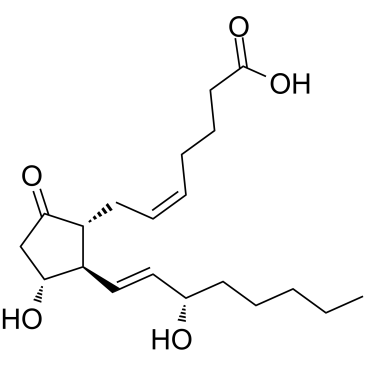| Cas No.: | 363-24-6 |
| Chemical Name: | Dinoprostone |
| SMILES: | O=C(C1)[C@@](C/C=CCCCC(O)=O)([H])[C@](/C=C/[C@@H](O)CCCCC)([H])[C@@H]1O |
| Formula: | C20H32O5 |
| M.Wt: | 352.471 |
| Purity: | >99% |
| Sotrage: | 2 years -20°C Powder, 2 weeks 4°C in DMSO, 6 months -80°C in DMSO |
| Publication: | [1]. Chouaib S, et al. The mechanisms of inhibition of human IL 2 production. II. PGE2 induction of suppressor T lymphocytes. J Immunol. 1984 Apr;132(4):1851-7. [2]. Fernandez-Repollet E, et al. In vivo effects of prostaglandin E2 and arachidonic acid on phagocytosis of fluorescent methacrylate microbeads by rat peritoneal macrophages. J Histochem Cytochem. 1982 May;30(5):466-70. [3]. Haylor J, et al. Renal vasodilator activity of prostaglandin E2 in the rat anaesthetized with pentobarbitone. Br J Pharmacol. 1982 May;76(1):131-7. |
| Description: | Prostaglandin E2 is a hormone-like substance that participate in a wide range of body functions such as the contraction and relaxation of smooth muscle, the dilation and constriction of blood vessels, control of blood pressure, and modulation of inflammation. |
| Target: | EP2 Receptor Human Endogenous Metabolite |
| In Vivo: | PGE2 (0.3 μg/k, i.p.) significantly reduces the number of peritoneab macrophages undergoing phagocytosis of the methacrybate microbeads in rats[2]. PGE2 (0.1 mg/min, i.a.) increases renal blood flow. PGE2 produces a biphasic change in renal vascular resistance, vasodilatation starts at 0.01 mg/min and is maximal at about 3 mg/min, while at the highest dose used (20 mg/min) PGE2 induces renal vasoconstriction[3]. |
| In Vitro: | PGE2 shows inhibition of IL 2 production in the mixture of irradiated and nonirradiated T lymphocytes. PGE2 (0.1-10 μM) dose-dependently inhibits the production of IL 2. PGE2 acts during the inductive phase of activation of suppressor cells. Preincubation of T lymphocytes with PGE2 induces cells that suppress IL 2 production and PHA proliferation[1]. |
| Cell Assay: | Lymphocytes in CM (1×106 cells/mL) are ditributed in microculture plates (100 μL) in triplicate in the presence of PGE-treated T cells or medium-treated T cells and stimulated with PHA-P at various mitogenic doses. After 72 hr, cultures are pulsed with 1 μCi [3H]thymidine per well (specific activity 5 Ci/mM) for 16 to 18 hr, collected with amicroprecipltator, dried, and counted in a liquid scintillation counter. |
| Animal Administration: | Male Sprague Dawley rats (200-250 g) are used throughout the study. For 3 consecutive days rats in the experimental groups receive a daily intraperitoneal injection of either PGE2 (0.3 μg/kg body weight (BW)), the prostaglandin inhibitor mecbofenamate (10 mg/kg BW) or the prostaglandin precursor arachidonic acid (0.3 μg/ kg BW). To determine whether or not 0.3 μg/kg BW of a fatty acid produces nonspecific effects, the biologically inactive fatty acid 11, 14, 17-eicosatrienoic acid is also administered to a group of rats. Rats in the control group receive an equivalent volume (2.0 mL/kg BW) of the vehicle. On the third day, 3 mL of a suspension containing 1.2×106 fluorescent methacrylate microbeads/mL of PBS are injected intraperitoneally (ip) into each rat. Six hours later all animals are given ip a regular dose of their respective treatment. Peritoneal exudate cells are harvested 19-22 hr later. |
| References: | [1]. Chouaib S, et al. The mechanisms of inhibition of human IL 2 production. II. PGE2 induction of suppressor T lymphocytes. J Immunol. 1984 Apr;132(4):1851-7. [2]. Fernandez-Repollet E, et al. In vivo effects of prostaglandin E2 and arachidonic acid on phagocytosis of fluorescent methacrylate microbeads by rat peritoneal macrophages. J Histochem Cytochem. 1982 May;30(5):466-70. [3]. Haylor J, et al. Renal vasodilator activity of prostaglandin E2 in the rat anaesthetized with pentobarbitone. Br J Pharmacol. 1982 May;76(1):131-7. |

 DC Chemicals' products qualify for U.S. tariff exemptions. We guarantee no price increases due to customs duties and maintain stable supply, continuing to deliver reliable research solutions to our American clients.
DC Chemicals' products qualify for U.S. tariff exemptions. We guarantee no price increases due to customs duties and maintain stable supply, continuing to deliver reliable research solutions to our American clients.





















